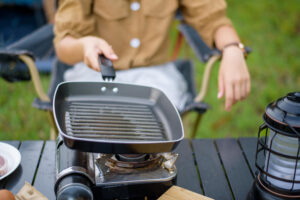Introduction
How To Seasoning Cast Iron Cookware Are you tired of struggling with sticky pans that ruin your culinary creations? Frustrated with the constant battle against rust and lackluster flavor in your dishes? Look no further! We have the secret to unlocking the full potential of your beloved cast iron cookware and elevating your cooking game to a whole new level.
Table of Contents
How To Seasoning Cast Iron Cookware is the time-honored culinary alchemy that transforms ordinary pans into culinary treasures, infusing your dishes with depth and richness that will leave your taste buds rejoicing.
Problem:
Sticky, hard-to-clean pans are the bane of every aspiring home chef. Flimsy non-stick coatings wear off, exposing your food to potentially harmful chemicals, and leaving you feeling unsatisfied with your culinary prowess. Not to mention, that pesky rust that appears at the most inconvenient times, makes you wonder if your cookware is even worth the hassle.
Agitate:
But fear not! There’s a simple yet powerful solution to all these kitchen woes. The answer lies in the ancient art of seasoning cast iron cookware. This transformative process not only creates a natural non-stick surface but also imparts a unique depth of flavor to your dishes that simply cannot be replicated with any other cookware material.
Solution:
From selecting the right type of cast iron cookware to mastering the step-by-step seasoning process, we’ll guide you through every aspect of How To Seasoning Cast Iron Cookware. We’ll explore the best oils to use, and the proper baking temperatures, and even troubleshoot any issues that may arise along the way. With our expert tips and tricks, you’ll be seasoning your cast iron like a seasoned pro in no time.
So, if you’re ready to unlock the culinary magic of seasoned cast iron cookware, join us on this gastronomic journey. Embrace the art of seasoning, and watch as your kitchen transforms into a haven of flavorful delights that will leave your family and friends in awe of your culinary prowess. Get ready to embark on a culinary adventure like no other, and savor the satisfaction of cooking with perfectly seasoned cast iron. Let’s dive into the world of How To Seasoning Cast Iron Cookware and unleash the full potential of your cooking experience!

Importance of Seasoning Cast Iron Cookware
Proper seasoning plays a vital role in the performance of your cast iron cookware. It forms a protective barrier against rust, preventing corrosion and ensuring longevity. Additionally, a well-seasoned surface allows for even heat distribution, reducing the chances of hot spots and providing consistent cooking results.
Benefits of Proper Seasoning
With a well-seasoned cast iron pan or skillet, you can enjoy the following benefits:
Enhanced Non-Stick Properties:
Proper seasoning creates a natural non-stick surface, making it easier to cook and clean your cast iron cookware.
Improved Flavor:
As the seasoning builds up over time, it imparts a unique and rich flavor to your dishes, adding depth to your culinary creations.
Healthier Cooking:
Seasoned cast iron requires less oil or fat for cooking, promoting healthier meals without compromising on taste.
I. Understanding Cast Iron Cookware
What is Cast Iron Cookware?
Cast iron cookware is made from molten iron that is poured into molds and then cooled to form a solid, heavy-duty piece of cookware. Its excellent heat retention and distribution properties make it a favorite among chefs and home cooks alike.
Advantages and Disadvantages of Using Cast Iron
Advantages:
Exceptional Heat Retention: Cast iron retains heat well, allowing for even and consistent cooking.
Versatility:
It can be used on stovetops, ovens, grills, and even over campfires.
Durability:
Properly cared for, cast iron cookware can last for generations.
Disadvantages:
Weight: Cast iron is heavy, which can make handling and storage challenging for some.
Initial Maintenance: New cast iron cookware requires how to seasoning cast iron cookware before use to develop its non-stick surface.
II. Preparing Your Cast Iron Cookware
Cleaning and Removing Residues
Before seasoning, it’s crucial to clean your cast iron thoroughly. Avoid using soap as it can strip away the seasoning. Instead, use hot water and a brush or scraper to remove any food residues. For stubborn stuck-on bits, sprinkle some coarse salt and scrub gently.
Drying and Heating the Cookware
After cleaning, thoroughly dry the cookware to prevent rust. You can place it on a stovetop over low heat for a few minutes to ensure complete drying.
III. Choosing the Right Seasoning Oil
Best Oils for Seasoning
Several oils work well for how to seasoning cast iron cookware, including:

Flaxseed Oil:
Known for its high smoke point and polymerization properties, flaxseed oil creates a durable seasoning layer.
Canola Oil:
With its neutral flavor, canola oil is an excellent choice for seasoning cast iron.
Avoiding Oils That Turn Sticky
While some oils are great for seasoning, others can turn sticky and leave a gummy residue. Avoid using oils with low smoke points, such as olive oil or butter, as they are more likely to polymerize improperly.
IV. Step-by-Step Seasoning Process to how to seasoning cast iron cookware
Applying the First Layer of Oil
Start by applying a thin layer of the chosen oil to the entire surface of the cast iron. Make sure to cover the inside, outside, and handle. Use a cloth or paper towel to spread the oil evenly.
Heating and Cooling Cycles
Place the oiled cast iron upside down in an oven preheated to a specific temperature (refer to the manufacturer’s recommendations). This process allows excess oil to drip off, preventing pooling. Heat the cookware for a specified time, then turn off the oven and let it cool inside.
Repeating the Seasoning Process
For optimal results, repeat the seasoning process several times. Each round of seasoning builds a stronger, more durable non-stick layer on the cast iron surface.
V. Troubleshooting and Maintenance
Dealing with Uneven Seasoning
If you notice uneven seasoning or sticky spots on your cast iron, simply re-season those areas by applying a thin layer of oil and repeating the heat and cooling cycles.
How to Fix Sticky Surfaces
To fix a sticky surface, place the cast iron in a self-cleaning oven cycle to remove the old seasoning. Afterward, re-season the cookware following the standard process.
Tips for Long-Term Maintenance
To maintain your well-seasoned cast iron, avoid using harsh cleaning agents or steel wool that can strip away the seasoning. Instead, opt for gentle cleaning methods and always ensure the cookware is thoroughly dried after each use.
VI. Common Seasoning Myths Debunked
Debunking Common Misconceptions
There are several myths surrounding the how to seasoning cast iron cookware, such as the need to use bacon fat or cook specific foods repeatedly to season the cookware. We’ll separate fact from fiction to help you achieve the best seasoning results.
Facts vs. Fiction in Cast Iron Seasoning
Cast iron cookware is a cherished kitchen essential known for its durability and excellent heat retention. Seasoning cast iron cookware is a vital step in maintaining its non-stick properties and preventing rust. However, amidst the sea of information, facts, and fiction can become entangled, leading to misconceptions about the seasoning process.
Fiction: Using bacon fat or specific foods repeatedly is the ultimate seasoning secret.
Fact: While bacon fat adds flavor, it doesn’t guarantee proper seasoning. Repeatedly cooking specific foods won’t achieve the desired results either. Proper seasoning requires applying a thin layer of oil and heating the cookware to polymerize the oil, creating a non-stick surface.
Fiction: Olive oil is ideal for seasoning cast iron.
Fact: Olive oil has a low smoke point and may turn sticky, leading to ineffective seasoning. Opt for oils with high smoke points, such as flaxseed or canola oil, which form durable seasoning layers.
Fiction: Dish soap ruins the seasoning.
Fact: Using dish soap to clean cast iron occasionally won’t harm the seasoning. Avoid prolonged exposure and harsh scrubbing, which may strip the seasoning. Instead, use hot water and gentle scrubbing to clean your cookware.
Fiction: Seasoning is a one-time process.
Fact: Proper seasoning is built over time. Multiple rounds of seasoning create a robust non-stick layer, improving with each application.
In conclusion, separating facts from fiction in cast iron seasoning is vital for achieving optimal results. Embrace the science behind how to seasoning cast iron cookware and enjoy the benefits of well-seasoned cookware in your kitchen.

Conclusion
Congratulations on mastering the art of how to seasoning cast iron cookware! Your dedication ensures outstanding cooking performance and delectable dishes for years to come. Embrace the heritage and tradition of using cast iron cookware, passed down through generations.
Celebrate the exceptional non-stick properties and even heat distribution unlocked by proper seasoning. From searing steaks to baking cornbread, your versatile cast iron cookware performs impeccably.
Preserve the prized seasoning through careful maintenance, avoiding harsh agents, and thorough drying after each use. Your well-cared-for cast iron will continue to shine, enriching your cooking experience.
Ignore common misconceptions about cast iron seasoning and make informed choices in the kitchen. Savor the flavors of cuisines worldwide with your seasoned cast iron cookware.
how to seasoning cast iron cookware Simplifying means nurturing your cast iron with love and care. Embrace its history, debunk myths, and enjoy the incredible benefits. Your kitchen will be transformed into a realm of seasoned success.
Dive into the world





Pingback: The 5 Best Cast Iron Cookware in India For the year 2023
Pingback: Beyond Ordinary Cookware: Discovering Triply Stainless Steel
Pingback: Exploring the Cast Iron 2 in 1 Grill Pan : Double the Taste